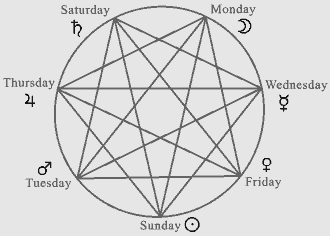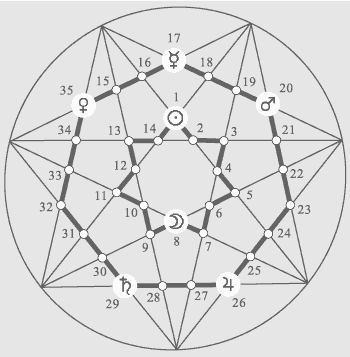Traditional Japanese garden of stones are motionless stones which do not
correspond with movement of time, but nevertheless motionless stones of a
Japanese garden can symbolize an instant of stopped time, or can symbolize
reference points of time according to which seasons or other natural events are
designated just as stones of Stonehenge designate the astronomical phenomena. In
essence stones of a Japanese garden can be used as objects which allow to
designate time, and also allow to measure time in the event that stones are
mobile. Namely if there is an opportunity to move stones then the Japanese
garden can be an original calendar where moving of stones symbolizes movement of
time.
That the garden of stones became a calendar, it is necessary to correlate lines
of a heptagonal geometrical network with calendar dates, that is necessary to
consider points of crossing of lines as locuses which correspond with calendar
dates and are adapted to moving stones. Namely it is necessary to consider a
heptagonal geometrical network of lines as calendar system according to which
stones can be arranged according to reference points of time and can be moved
according to movement of time.
Within the framework of a heptagonal network there are seven points which
correspond with apexes of a heptagon and points of contemplation of a Japanese
garden that correspond to seven days of week and allows to correlate stones to a
calendar. If the space of a garden is not limited then it is possible to
determine seven points for contemplation of a garden within seven days of week,
and if the space is limited then there can be only some points which are
intended for contemplation of a Japanese garden of stones in some days of week.
But in any case necessarily there is one basic point of contemplation concerning
which a Japanese garden of stones is focused in space and is connected to
environmental district, and other points of contemplation can exist if the space
is not limited also a garden of stones is perfect, or existence of other points
of contemplation can be imagined.
The chart shows conformity of seven days of week and seven points of
contemplation:
 |
As it is possible to see, the heptagonal network of
lines forms a figure which name "Star of Magicians" and is applied in
astrology to comparison of days of week to planets, that astrological
symbols of planets show on the chart. Points of contemplation of a Japanese garden of stones correspond with the astrological Star of Magicians and planets, and accordingly correspond with 7 days of week. The basic point of contemplation corresponds to Sunday as this day weeks corresponds with the sun which is the main astrological symbol. It is possible to choose other day of week and other planet for the basic point of contemplation, but the sun is the basic heavenly body which should symbolize the key point of a Japanese garden of stones. |
Stones of a Japanese garden can have the different sizes and different colors
that should correspond to attributes of planets in astrology:
Sun - biggest light or yellow stone;
Moon - biggest black stone;
Mercury - smallest stone;
Mars - red stone;
Venus - green or blue stone;
Jupiter - grey or white stone;
Saturn - black or dark stone.
These are approximate attributes of stones according to attributes of planets in
astrology, but real stones can have insignificant differences from the listed
attributes as a necessary condition is the opportunity to distinguish stones and
to compare to planets, and it supposes some variations of attributes.
Besides variations of attributes allow to select harmonious combinations of
stones according to the sizes and colors, or allows to collect stones in
harmonious groups in the event that groups of three or other number of stones
symbolizes planets.
If stones of the Japanese garden are motionless it is possible to observe a rule
according to which each stone should be seen from a point of contemplation which
symbolizes the appropriate day of week and astrological planet. If any stones
are invisible from those or other points of contemplation it is expedient that
inappropriate stones were invisible. For example, the stone-symbol of the planet
Mars can be invisible in the point of contemplation which corresponds to Friday
and corresponds to the planet Venus provided that the stone-symbol of the planet
Mars can be latent by the stone-symbol of the planet Venus. That is arrangements
of stones can be "adjusted" as a musical instrument according to astrological
attributes of planets and according to ratio of planets with points of
contemplation.
If stones of a Japanese garden are mobile or it is supposed, that stones can be
moved, then it is possible to speak that the garden of stones is megalithic or
is a garden of mobile megaliths.
Preliminary stones of a megalithic garden can be located how is shown on the
chart:
 |
Stones are shown by white circles and by the
appropriate symbols of planets. Small white circles and numbers designate locuses (places) where stones settle down during movement. Thick dark lines among lines of heptagonal geometrical network allocate outside and inside contours which specify the order for movement of stones. Namely numbers from 1 up to 14 designate locuses of inside contour and numbers from 15 up to 35 designate locuses of outside contour. Two stones correspond with the sun and the moon and are located on the inside contour and move in locuses of inside contour, and five stones move in locuses of outside contour and correspond with five planets. |
Movement of stones is carried out consistently. Namely move any one stone and
when movement of this stone not probably then move the following stone which
became an obstacle for movement of the previous stone.
For example, the stone-symbol of Mercury move from 17th place up to 19th place
and then move the stone-symbol of Mars from 20th place up to 25th place, and the
stone-symbol of Mercury leave in 19th place. Then move the stone-symbol of
Jupiter from 26th place up to 28th place, and the stone-symbol of Mars leave in
25th place and so on.
If on the inside contour there are two stones and on the outside contour there
are five
stones, and stones move according to the listed rules then on the inside contour for
returning in primary position of all stones it is
necessary 84 movements and for returning in primary position of all stones on the
outside contour it is necessary 1680 movements.
If on the outside contour to move stones once a week then for returning stones
in primary position it is necessary approximately 32 years and 3 months, that
has concrete esoteric sense. And if on the inside contour to move stones once a
year then for returning stones in primary position it is necessary 84 years,
that is equal to the cycle of the planet Uranus.
The detailed information on cycles of the planet Uranus
look on a site: www.emotions.64g.ru/apf/apf1en.htm.
If to arrange on outside and inside contours other numbers of stones then it is
possible to calculate other chronological periods of time. And also if to use
other periodicity of movement of stones then it is possible to calculate a
various chronological periods of time.
If on the outside contour to arrange two stones and to make movement of stones
once a week then for returning stones in primary position it is necessary
approximately 12 years, that there corresponds to the cycle of the planet
Jupiter. And if on the inside contour to arrange five stones and to make
movement of stones once a year then for returning stones in primary position it
is necessary approximately 168 years, that there corresponds to two cycles of
the planet Uranus.
If to take into account that 168 years is 14 twelve-year periods (14x12=168)
then movement of two stones on the outside contour and movement of five stones
on the inside contour forms two conterminous cycles which are a magnificent
calendar for calculation of time.
Also other chronological periods of time can be calculated if to arrange three
stones and four stones, or four stones and three stones on outside and inside
contours.
Thus, a megalithic garden of mobile stones can be a calendar by means of which
calculate chronological cycles of planets and determine ratio of planets, which
can be seen in arrangements of stones if to look at stones from different
points of contemplation in different days of week. If stones are motionless then
in various arrangements of motionless stones of a Japanese garden it is possible
to fix any significant events of time if to have stones according to the shown
chronological chart.
The following page describes games and puzzles which can be played by means of moved stones of a Japanese garden (moved stones of a megalithic garden).